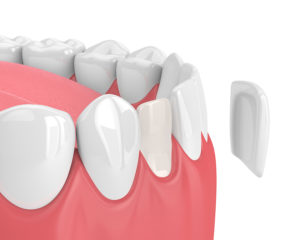By: Dr. Elizabeth Eggert
Cracked, discolored, misshapen and decaying teeth can dramatically impact a person’s self-confidence. If you’re considering redoing your smile, but aren’t sure which route to go, read on! We’ll discuss dental crowns and veneers and highlight some of the differences so together, we can help you determine which option is best for you.
 What are crowns?
What are crowns?
Made from porcelain, ceramic or metal, crowns are about 1.5 mm thick and cover the entire tooth. Crowns are an excellent choice for teeth that are structurally compromised and need additional support.
What can I expect from the crown process?
If your tooth is decaying, Dr. Elizabeth or Dr. Jeff will start by removing the decay. Then they will reshape your tooth to create space for the crown. Next, Dr. Elizabeth or Dr. Jeff will take a digital image or putty impression of your prepared tooth which helps to ensure that your crown is a perfect fit. Depending on whether you’ll have your crown fabricated same-day in the office with the CEREC crown procedure or if your crown will be made at the dental lab, there will be some wait time. With a CEREC crown, you’ll go home with your final crown on the same day. With a laboratory fabricated crown, a temporary crown will be placed on your tooth initially to help protect it during the 2 weeks the crown is being made. Ultimately, your final crown is cemented into place and should last many years.
Pros and cons of crowns
 Because the entire tooth is covered, the tooth is less likely to fully fracture or split than with other restorations like veneers or fillings. Porcelain crowns can look and feel good and can be color-matched to blend with your natural teeth. Crowns generally feel very natural.
Because the entire tooth is covered, the tooth is less likely to fully fracture or split than with other restorations like veneers or fillings. Porcelain crowns can look and feel good and can be color-matched to blend with your natural teeth. Crowns generally feel very natural.
Crowns do require more tooth preparation than veneers and sometimes this can put the tooth at higher risk of tooth sensitivity or nerve damage.
 What are veneers?
What are veneers?
Manufactured most commonly from porcelain, veneers are less than 1mm thick and cover the front of a natural tooth. Veneers can also be made directly from composite resin, or plastic. These typically need to be repaired or replaced more frequently than porcelain veneers.
What can I expect from the veneer process?
Similar to the crown preparation process, the veneer preparation process requires Dr. Elizabeth or Dr. Jeff to reshape your tooth to create space for the veneer. Next, a putty impression of your prepared tooth is taken which helps to ensure that your veneer is a perfect fit. While you’re waiting for your permanent veneer to be manufactured, Dr. Elizabeth or Dr. Jeff will place a temporary veneer on your prepared tooth to protect it. Ultimately, your final veneer is bonded to your tooth and the cement is hardened with a bright blue curing light.
Pros and cons of veneers
Porcelain veneers are an excellent choice for cosmetic restorations and are a conservative way to help correct misshapen teeth. Veneers can also be color-matched so they blend seamlessly with the rest of your teeth or they can be made in a lighter shade to give you the bright smile you’ve always dreamed of.
If you’re thinking about dental restorations and would like to know more about your options, Dr. Elizabeth Eggert or Dr. Jeff Eggert would love to speak with you. Call our office at 651.482.8412!

